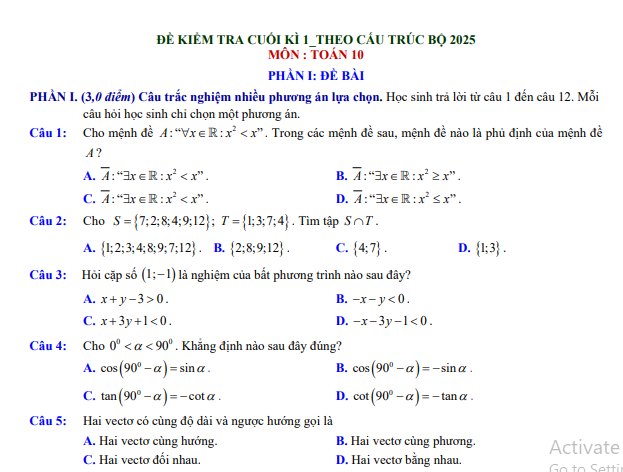Vietnam: What are the 1st end-of-semester question papers and answers for 10th-grade Mathematics? What knowledge does the 10th-grade Mathematics curriculum cover?
What are the 1st end-of-semester question papers and answers for 10th-grade Mathematics in Vietnam?
The below 1st end-of-semester question papers and answers for 10th-grade Mathematics are important materials to help students review and test the knowledge they have acquired throughout the semester.
Students can refer to the following 1st end-of-semester question papers and answers for 10th-grade Mathematics:

Download 1st end-of-semester question papers for 10th-grade Mathematics - No. 1.
Download 1st end-of-semester question papers for 10th-grade Mathematics - No. 2.
Download 1st end-of-semester question papers for 10th-grade Mathematics - No. 3.
Download 1st end-of-semester question papers for 10th-grade Mathematics - No. 4.
Download 1st end-of-semester question papers for 10th-grade Mathematics - No. 5.
Note: The content is for reference only.

What are the 1st end-of-semester question papers and answers for 10th-grade Mathematics in Vietnam? What knowledge does the 10th-grade Mathematics curriculum in Vietnam cover? (Image from Internet)
What knowledge does the 10th-grade Mathematics curriculum in Vietnam cover?
Under Section 5 of the General Education Program for Mathematics issued with Circular 32/2018/TT-BGDDT, 10th-grade students are taught the following knowledge:
(1) Set Theory and Propositions
- Mathematical propositions. Negation of propositions. Converse propositions. Equivalent propositions. Necessary and sufficient conditions.
- Sets. Operations on sets.
(2) Inequalities and Systems of Inequalities in Two Variables
- Inequalities, systems of inequalities in two variables, and applications.
(3) Functions and Graphs
- Basic concepts of functions and graphs.
- Quadratic functions, quadratic graph functions, and applications.
- Sign of quadratic trinomial. Quadratic inequality in one variable.
- Equations reducible to quadratic equations.
(4) Combinatorics
- Counting principles (addition, multiplication, permutations, combinations) and applications in practice.
- Newton's Binomial with an exponent not exceeding 5.
(5) Trigonometric Ratios in Triangles and Vectors
- Trigonometric ratios in triangles. Law of cosines. Law of sines. The formula for calculating the area of triangles. Solving triangles.
- Vectors, operations (addition and subtraction of vectors, scalar multiplication of a number with a vector, scalar product of two vectors) and some applications in Physics.
(6) Coordinate Geometry in a Plane
- Coordinates of vectors in a coordinate system. Coordinate expressions of vector operations. Applications in solving triangle problems.
- Lines in the coordinate plane. General and parametric equations of lines. Distance from a point to a line.
- Circles in the coordinate plane and applications.
- Three conics in the coordinate plane and applications.
(7) Approximation Numbers
- Approximation numbers. Errors.
- Collecting and organizing data.
- Describing and representing data in tables and charts.
(8) Data Analysis and Processing
- Characteristics measuring central tendencies for ungrouped data samples.
- Characteristics measuring dispersion for ungrouped data samples.
(9) Concepts of Probability
- Some concepts of classical probability.
(10) Probability Calculation Rules
- Practicing probability calculations in simple cases.
- Probability calculation rules.
What experiential activities in the Mathematics curriculum do 10th-grade students in Vietnam participate in?
According to Section 5 of the General Education Program for Mathematics issued with Circular 32/2018/TT-BGDDT, 10th-grade students may participate in experiential activities in the Mathematics curriculum as follows:
Activity 1: Practicing the application of mathematical knowledge in reality and interdisciplinary topics, such as:
- Practical synthesis activities related to calculations, measurements, estimations, and creating shapes, such as: calculating taxi fares according to various price frames: under 1km, 1 - 10km, 10 - 31km, above 31km, etc.; measuring certain features of objects that cannot be directly measured using tools; calculating the height of architectural structures in Parabola form (such as Nhat Tan Bridge, Truong Tien Bridge, My Thuan Bridge, etc.); explaining phenomena, laws in Physics; practicing drawing and cutting shapes in Ellipse form.
- Practicing data description and representation in tables and charts.
Activity 2: Exploring some financial knowledge, such as:
- Understanding the difference between saving and investing.
- Practicing setting up a personal investment plan to achieve the desired growth rate.
Activity 3: Organizing extracurricular activities such as math clubs, study projects, math games, math competitions, such as: quiz contests on the history of mathematics, organizing math club meetings on topics (exploring applications of quadratic functions, vectors in practice, etc.).
Activity 4 (if the school has conditions to implement): Organizing exchanges for talented students within the school and with other schools, along with experts to gain a better understanding of the role of Mathematics in practice and in various professions.

